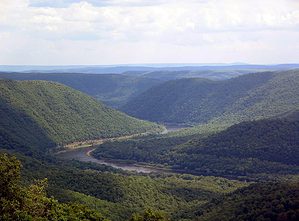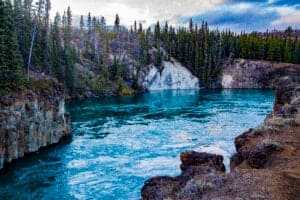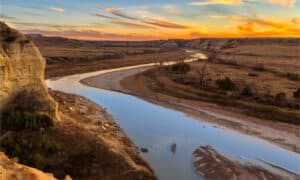The Kootenai River is a 485-mile river that flows through the Pacific Northwest region of North America. There are two ways of saying its name, Kootenay in Canada and Kootenai in the USA. Glaciers and snowmelt primarily feed this river, as its drainage basin flows from British Columbia, Canada, through Montana and Idaho, covering an area of around 19,420 square miles. But what’s in the Kootenai River, and is it safe to swim in?
Is it Safe to Swim in the Kootenai River?
There are designated swimming areas on the Kootenai River, including:
- Clark Fork River Area
- Dorr Skeels Campground
- Bull Lake Area
- Logan State Park
- Triangle Pond
- Fisher River Area
- McGillivray Campground
- Koocunusa Area
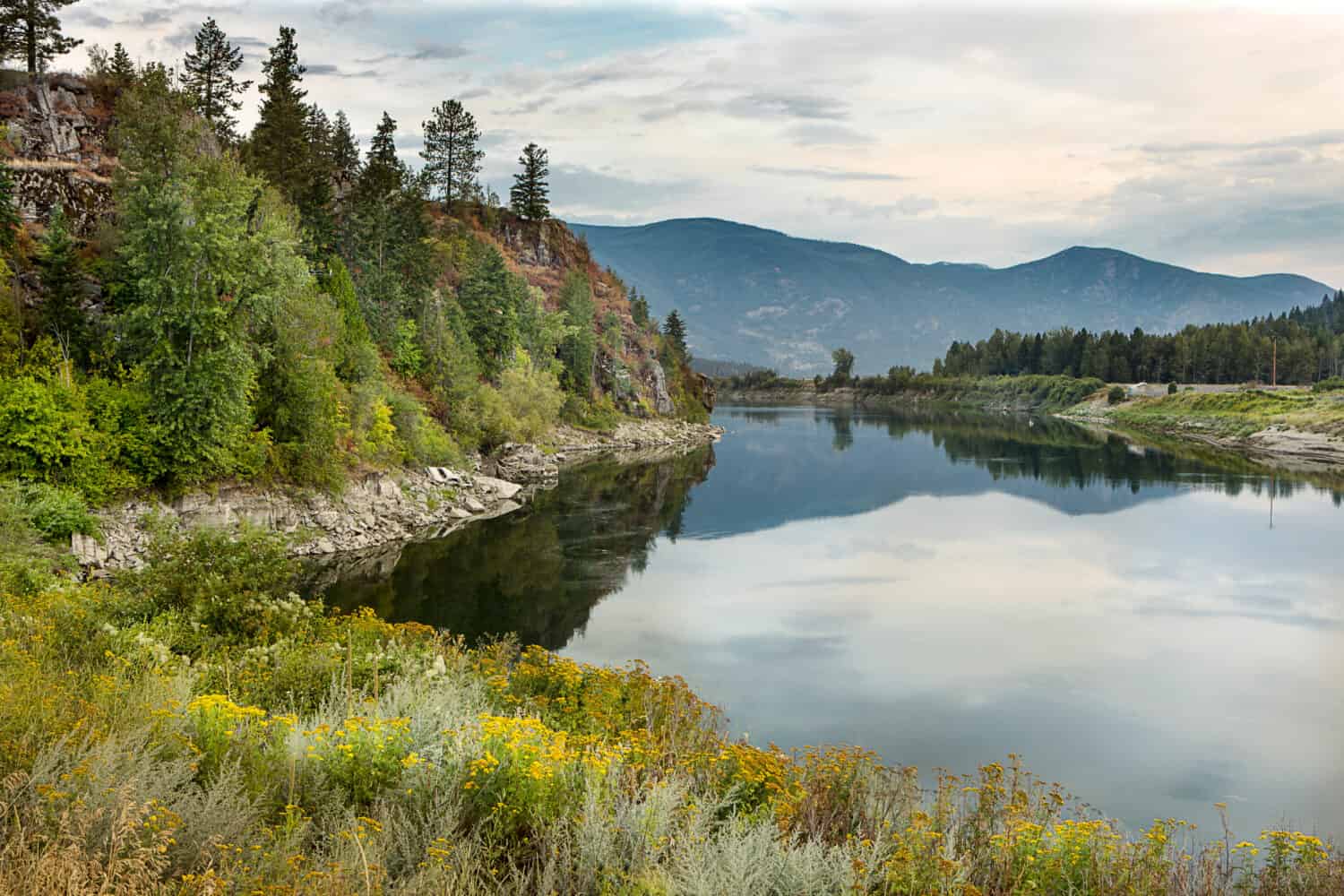
There are designated swimming areas on the Kootenai River.
Image: Gregory Johnston, Shutterstock
©Gregory Johnston/Shutterstock.com
Pollution in the Kootenai River
The Kootenai River plays a critical role in the ecosystems of native and threatened fish species, as well as land animals like the woodland caribou and grizzly bear. But, unfortunately, wildlife in and around the river is threatened by waste and runoff from mining. Furthermore, matters will only worsen as these mines have proposed expansions. For example, five open-pit coal mines are approved for expansion along the Elk River in Canada, a tributary to the Kootenai River. As a result of ongoing mining, a naturally occurring element called selenium is being released and becomes toxic in an aquatic environment. While swimming is still allowed in the river, these toxins harm the wildlife that relies on the river.
Wildlife in the Area
As mentioned above, the Kootenai River provides various habitats for multiple species, including larger animals, like:
Grizzly Bear
The grizzly bear is native to Montana and plays a vital role in its ecosystem. However, people tend to steer clear of these massive omnivores as they can be aggressive and cause harm. Grizzlies are known for injuring or killing humans and livestock. In addition, they can cause quite a bit of property damage and economic loss. Therefore their presence is both mesmerizing and feared. Adult grizzlies are normally solitary except when they have cubs or during mating season.
They have large territories as males roam areas of 600 to 1,000 square miles, while females have territories of up to 100 square miles. Since these bears can walk between 20 to 40 miles daily, it’s not hard to patrol.
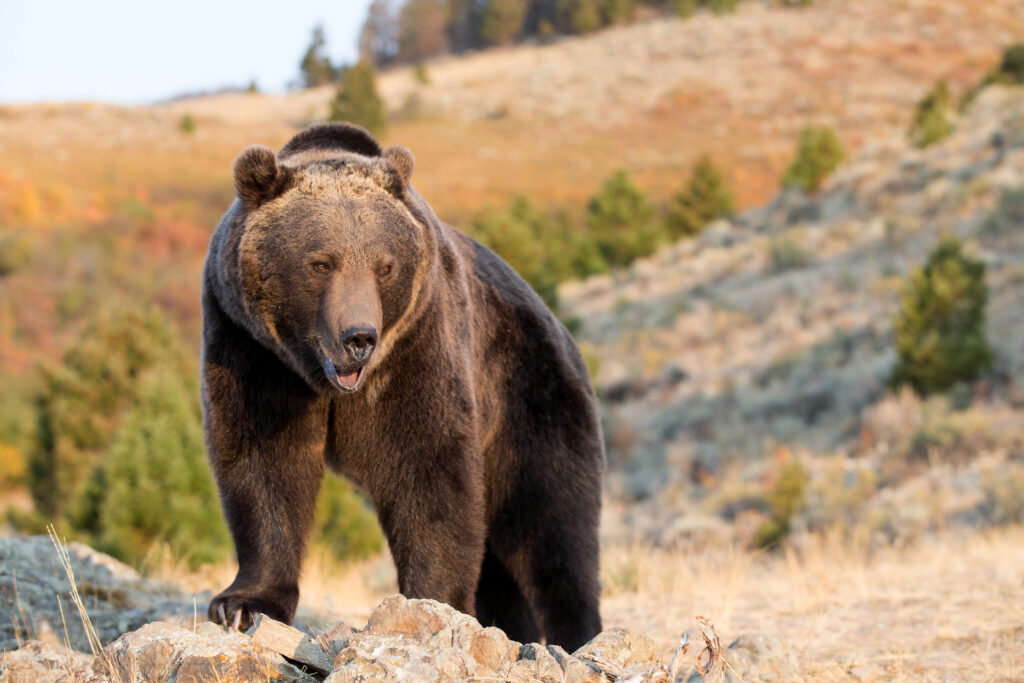
Adult grizzlies are normally solitary except when they have cubs or during mating season.
©Dennis W Donohue/Shutterstock.com
Woodland Caribou
The woodland caribou usually occur in old-growth or mature conifer forests. However, they also inhabit western redcedar, subalpine fir, western hemlock, and Engelmann spruce forests. They mainly consume lichens, an organism that grows on trees. But, their diet also consists of leaves, mushrooms, huckleberry, and sedges.
When female caribous are ready to give birth, they move to higher elevations, away from predators and humans. Unfortunately, these deer are the most endangered mammal in the lower 48 states. For example, there are around 41 individuals left in the Selkirk Mountains, and there is no sign of the population increasing.
Deer
Some of the most healthy white-tailed deer inhabit areas around the Kootenai River in Montana. These deer are usually large, plentiful, heavy, and have incredible genetics and racks. The remote location of the river enhances the deer’s populations, and they are protected from any major drops in numbers due to hunting, predators, or disease.
These deer are very adaptable and can survive in various habitats like rivers, wetlands, forests, bushy areas, and creeks. Additionally, they have varied diets consisting of berries, twigs, fruits, leaves, chokecherry, snowberry, serviceberry, and ninebark. Adult male white-tailed deer weigh between 225 to 300 pounds, while females weigh 150 to 190 pounds. While these deer run around 35 to 40 miles per hour and can jump 9 feet high, they still fall prey to local predators like mountain lions.
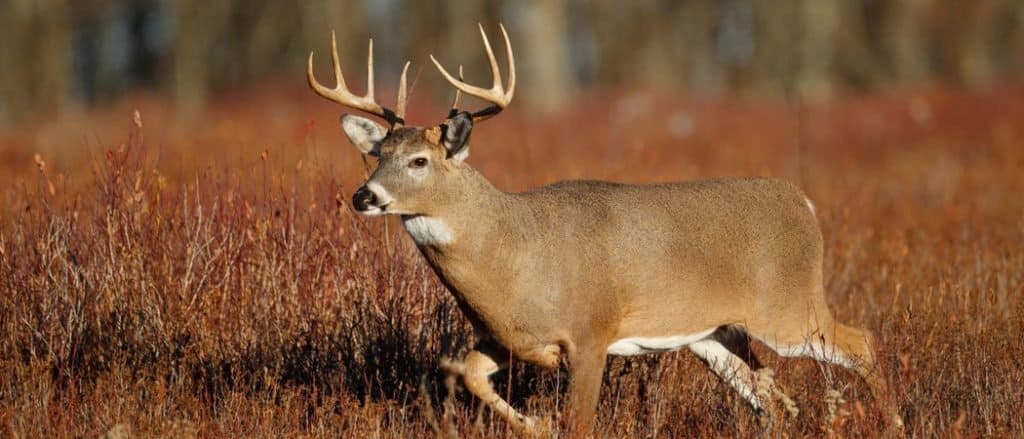
Adult male white-tailed deer weigh between 225 to 300 pounds, while females weigh 150 to 190 pounds.
©Paul Tessier/Shutterstock.com
Elk
Kootenai Country in Montana is home to a large population of Rocky Mountain elk. The Native Americans in the area called these elk Wapiti, meaning “large white deer,” which makes perfect sense if you have ever seen one in winter with its light buckskin coat. These elk grow large, with males reaching 700 to 1,200 pounds and females weighing between 400 to 650 pounds. Males sport massive spreading antlers with around five tines projecting from the main antlers.
Rocky Mountain elk in the Kootenai area primarily graze on grasses, sedges, and forbs during the summer and will switch to browsing on ceanothus, serviceberry, and willows during winter. Additionally, they will eat young trees like chokecherry, maple, and conifers.
Their main predators are packs of coyotes, wolves, black bears, grizzly bears, mountain lions, bobcats, and Canadian lynx. However, wolverines will eat elk carrion, and golden eagles will attack calves. These elk can survive in several habitats, including openings of natural meadows, coniferous forests, old burns, grassy hillsides, and recently logged areas starting to regrow.
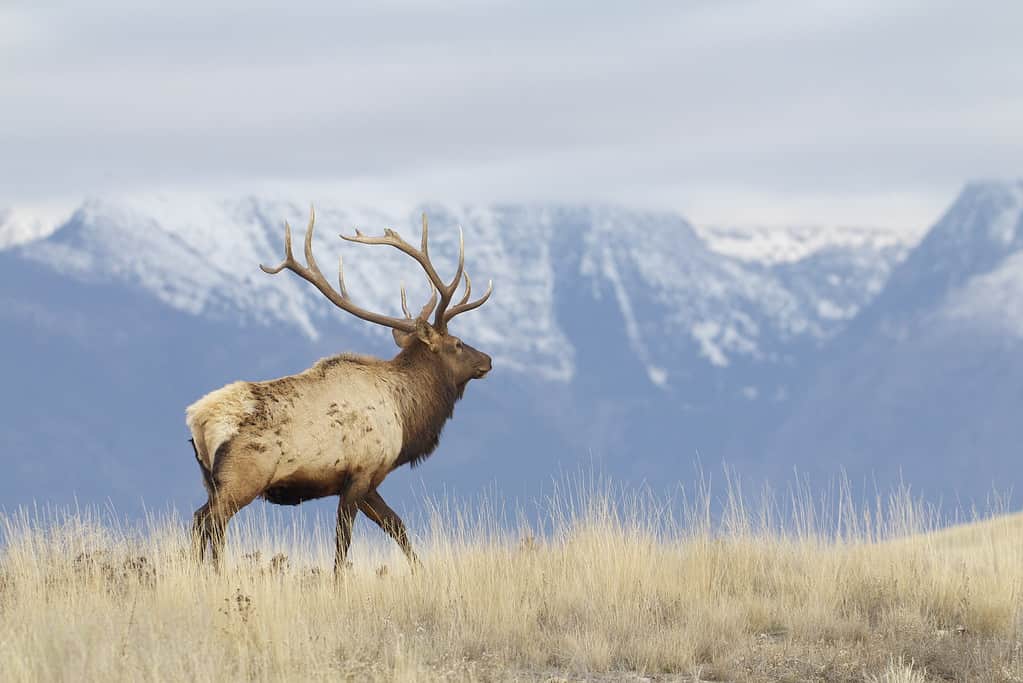
Rocky Mountain elk in the Kootenai area primarily graze on grasses, sedges, and forbs during the summer and will switch to browsing on ceanothus, serviceberry, and willows during winter.
©Tom Reichner/Shutterstock.com
Wolves
Gray wolves, also called the western wolf or timber wolf, are the largest species of wild dogs, with males weighing between 90 to 120 pounds and measuring 75 inches long. Females are slightly smaller, weighing 70 to 85 pounds and growing 68 inches long. These wolves inhabit areas around the Kootenai River in Montana. Some are black with several color combinations, and others are a gray-tan color.
While these wolves do not migrate, they follow migrating herds to ensure they always have a food source. Gray wolves aren’t fussy eaters, and their diet varies depending on what’s available. For example, they prefer hunting elk, deer, moose, and woodland caribou but will also prey on beavers, snowshoe hares, small rodents, carrion, and sometimes vegetation. Gray wolves prefer to inhabit secluded areas far away from human activity.
Gray wolves are apex predators, which means they are at the top of the food chain in their environment and rarely have predators. Therefore, they will dominate other canines in the area. For example, wolves will attack coyote dens, and kill their offspring, especially during the colder months when coyotes try to steal wolves’ kills. While these wolves are apex predators, they occasionally confront mountain lions, black bears, grizzly bears, and golden eagles that try to hunt their pups.
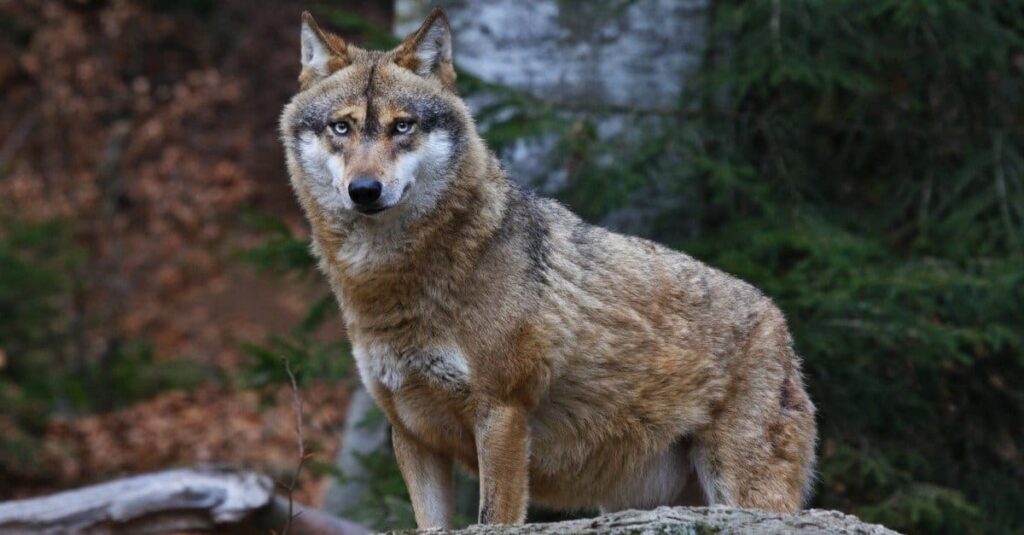
Gray wolves aren’t fussy eaters, and their diet varies depending on what’s available. For example, they prefer hunting elk, deer, moose, and woodland caribou but will also prey on beavers, snowshoe hares, small rodents, carrion, and sometimes vegetation.
©Bildagentur Zoonar GmbH/Shutterstock.com
Mountain Lion
Kootenai River is also home to mountain lions. These large, powerful cats like to hunt from trees, jumping on top of their prey and suffocating them with a bite to the neck. They are brown along their backs with white bellies. Males can grow to 8 feet long and weigh 150 to 220 pounds, while females weigh between 80 to 130 pounds.
Mountain lions inhabit areas with adequate food, territory, and cover, like mountains, foothills, wetlands, and other areas close to water sources. However, they are extremely adaptable and can thrive in almost any habitat. As a result, they have the greatest range of any large terrestrial mammal in the western hemisphere.
They also have a diverse diet of grasshoppers, insects, small rodents, grouse, western cottontails, snowshoe hares, coyotes, raccoons, mink, otters, and sometimes snakes. However, they primarily prey on mule deer, elk, white-tailed deer, and moose. In the Kootenai region, mountain lions hunt throughout the day but are seldom seen. These wary cats ensure they are out of sight before anyone has time to spot them.
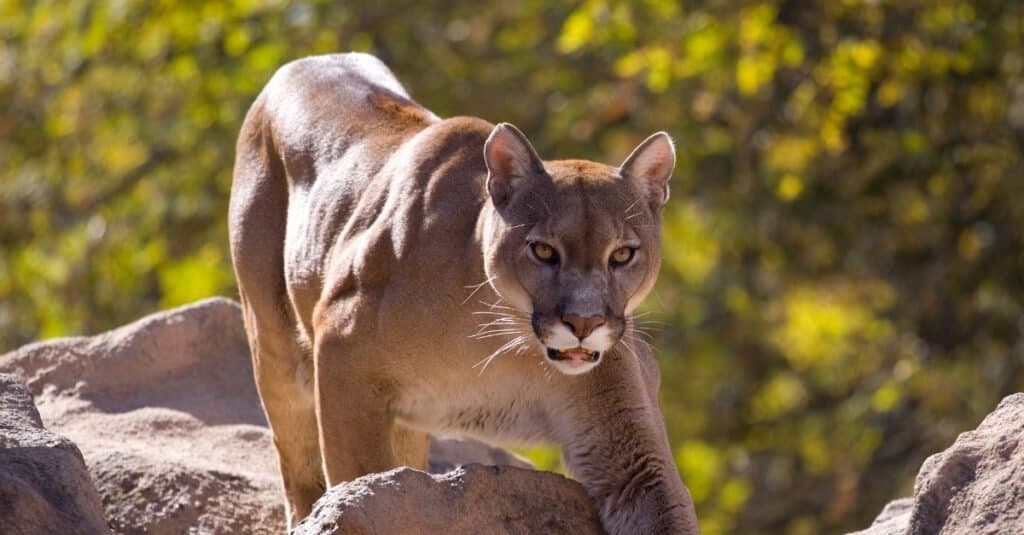
Mountain lions inhabit areas with adequate food, territory, and cover, like mountains, foothills, wetlands, and other areas close to water sources.
©iStock.com/SandmanXX
The photo featured at the top of this post is © melissamn/Shutterstock.com
Thank you for reading! Have some feedback for us? Contact the AZ Animals editorial team.




